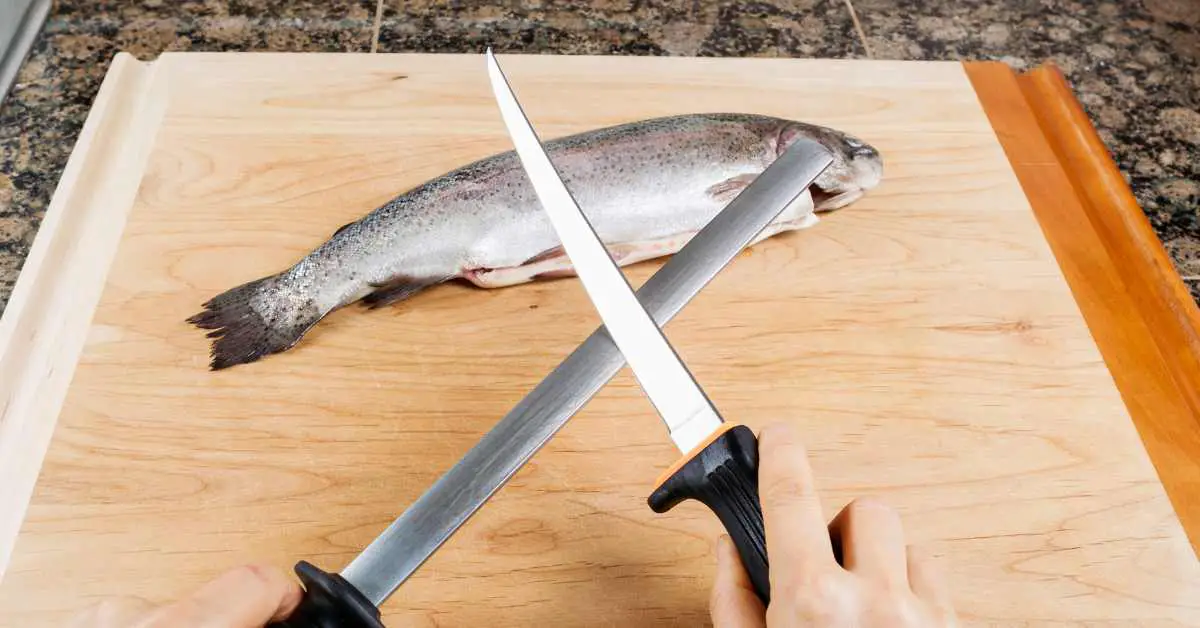Ever try to fillet your day’s catch, like a hefty striped bass, only to struggle with a dull knife? A fillet knife can lose its edge over time. So, how do you regain that sharpness? Don’t worry, by the end of this guide, you’ll master the art of fillet knife sharpening. You’ll be able to cut through your catch smoothly, making the most of your fishing trip. Let’s get started!
So, How Do You Sharpen a Fillet Knife?
Sharpening a fillet knife is more of an art than a chore. The key to a great edge is rubbing the knife’s edge on a sharpening stone with consistency.
Keeping the same angle throughout the sharpening process is essential for achieving a razor-sharp edge. However, it takes a lot of practice and patience to master.
A common debate among fishing enthusiasts and chefs alike is whether to aim for a polished or coarse edge when sharpening your knife.
For filleting, I recommend going for a polished edge as it cuts through meat fibers smoothly and requires less maintenance than a coarse edge.
Honing vs Sharpening a Knife
Sharpening and honing may sound the same, but they serve different purposes.
Sharpening involves grinding away the metal from the blade to create a new edge. Honing aligns the existing edge without removing any metal. As you can see, sharpening is a more involved process.
The key to a sharp blade is a combination of both these processes.
You need to first sharpen the knife to create the edge, and then hone it to maintain that sharpness for longer.
Remember, a sharp knife is a safe knife.
How to Hone a Knife
Now, how does one hone a knife? It’s pretty straightforward.
You use a tool called a honing steel. Place your blade against the honing steel at an angle, usually around 20 degrees, and glide it along the length of the steel from base to tip.
Repeat this several times on both sides of the knife blade, and voila! Your knife edge is realigned and ready for action.
How to Sharpen a Knife
When it comes to sharpening, start by setting the knife against your sharpening stone at the correct angle.
Move your knife along the stone as if you’re trying to slice a thin layer off it. Do this on both sides of the blade until you can feel a small ‘burr’ forming along the edge.
This burr is a tiny, visible fold of metal that indicates your knife is getting sharpened. Keep sharpening until this burr runs from the heel to the tip of your knife.
Clamping Fillet Knives
- Use a reliable knife clamp to secure your fillet knife.
- Adjust the angle of the clamp according to the desired edge angle of your knife.
- Make sure the knife is tightly secured, but be careful not to damage the blade.
Tips for Caring for Your Fillet Knife
Regular maintenance of your fillet knife is very important to its longevity and performance. Here are some pointers:
Cleaning
Always clean your knife after every use. This prevents residue from damaging the blade and handle.
Storage
Store in a dry, safe place, away from other utensils that could scratch or damage it.
Regular Honing
Regular honing helps maintain the blade’s sharpness and extends the time between sharpening.
Inspection
Inspect your knife for any signs of damage before every use. If you notice any chips or nicks, it’s time to sharpen.
Professional Sharpening
If you’re unsure about sharpening your knife yourself, consider getting it professionally sharpened.
While this may seem to be over-the-top for home use, professional sharpening services are regularly used for restaurants and seafood markets.
Overcoming Blade Flex While You Sharpen
Sharpening a flexible blade like that of a fillet knife can be a challenge, but there are ways to overcome this.
- Stabilize the blade: Using a clamp can help stabilize the blade and prevent it from flexing during sharpening.
- Apply gentle pressure: Too much pressure can cause the blade to flex. Use gentle, consistent strokes when sharpening.
- Sharpen slowly: Take your time. A slow, deliberate approach helps maintain control and minimizes flexing.
Best Products to Use When Sharpening a Fillet Knife
Choosing the right sharpening tool can make all the difference. Here are a few recommendations:
Sharpening Stones
Available in different grit sizes, they’re ideal for precision sharpening.
Honing Steel
Essential for maintaining your knife’s edge between sharpenings.
Electric Knife Sharpener
Offers quick and easy sharpening, but less control.
Sharpening Systems
These include clamps and guides to help maintain the correct angle.
Knife Clamp
This accessory is important for keeping your knife steady during the sharpening process.
How Long Does a Fillet Knife Last?
The lifespan of a fillet knife heavily depends on its usage and care.
With proper maintenance, your fillet knife can serve you for many years.
However, a poorly cared-for knife may need replacement within a year or two.
Remember, taking care of your fillet knife means not just sharpening but also cleaning, storing properly, and regular honing.
Things to Consider When Buying Your First Fillet Knife
- Flexibility: A good fillet knife has a certain degree of flexibility to navigate around bones and under the skin of the fish.
- Blade Material: Look for high-quality steel blades for durability and sharpness.
- Handle: The handle should be comfortable to hold and offer a good grip, even when wet.
How Often Should I Sharpen My Knife?
Sharpening frequency depends on how often and how rigorously you use your knife.
However, a good rule of thumb is to sharpen your knife when you notice it’s not performing as well as it used to. For regular kitchen use, I recommend blade sharpening once a month.
Honing your knife regularly can also extend the intervals between sharpening.
Things to Know
Here are a few tips to remember:
- Safety First: Always handle your knife with care. Sharp knives can be dangerous if mishandled.
- Use the Right Tools: Using the right sharpening tools makes the process easier and more effective.
- Patience Pays: Sharpening a knife is a skill. It takes time and practice to perfect.
How to Sharpen a Fillet Knife
Sharpening a fillet knife may seem challenging at first. With patience and practice, it becomes a simple part of your meat preparation routine. Remember, a sharp knife is the secret to bone-free fillets. So, next time you’re back from a fishing trip, and you’ve got your catch ready to be filleted, you’ll know exactly what to do.

Claudia Faucher is a fitness trainer and lifestyle blogger, who recently started to pursue her other passions… Southern cooking and creating recipes.







